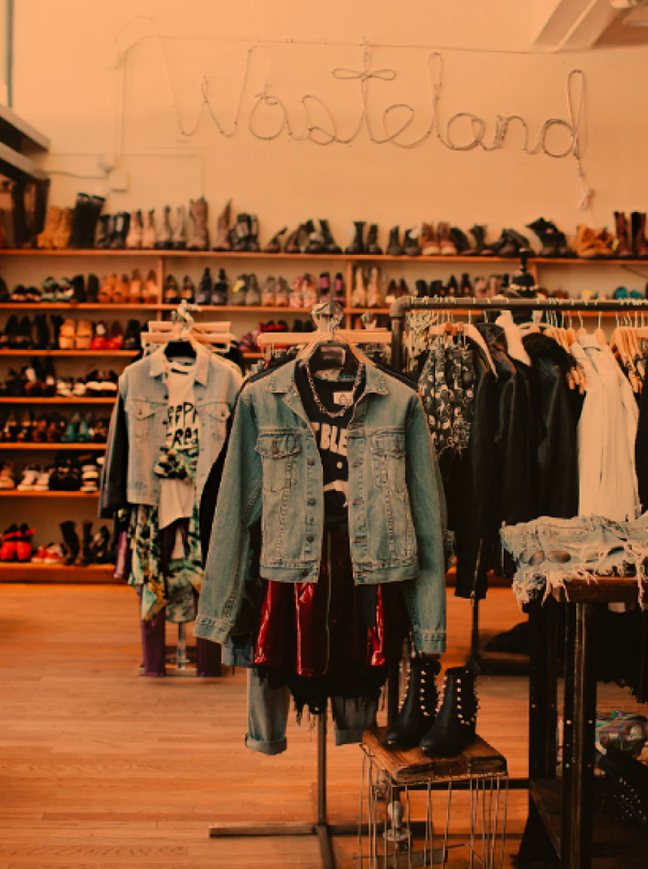Fast fashion companies are known for their unethical practices. Popular brands including H&M, Forever 21, Nike, and countless others manufacture their clothes with practices that violate human rights with their use of child labor, unfair wages, and dangerous working conditions. However, the fashion industry has an additional dark side; after the oil industry, the fashion and textile industry is the second most polluting industry in the world.
According to the United Nations, the fashion industry accounts for 10% of global carbon emissions and 20% of global wastewater. As responsible consumers, we have the agency to approve or boycott companies based off of their environmental and labor practices, so we can have a huge impact on the planet simply by adjusting our habits when it comes to fashion. Here we walk you through the ways you can reduce the environmental footprint of your closet from how to decide what stores you buy your clothes from, washing and drying them, and eventually removing them from your closet when you no longer want them.
Shop smarter, not harder: Things to do while you shop
Hold the Plastic - Reusable bags go beyond grocery shopping! Bring your own reusable bag while clothes shopping so you don’t have to take the plastic bag they’ll offer you. Using your own bags for your shopping reduces plastic waste in landfills, which is important because plastic can take 500 years to degrade.
Buy from vintage or thrift stores - Vintage clothing isn’t just a style upgrade, it also helps reduce your carbon footprint because it keeps you from buying something new. Thrift shopping has the same effect, and although it may be hard to find clothes that you like, if you are discerning and patient while sifting through all the options, you can find some amazing and unique pieces. You can even make a day out of it by going with your friends, which will make it more fun and encourage them to implement eco-friendly fashion into their wardrobes. We recommend trying Buffalo Exchange and Love The City. Thrift shops are usually significantly cheaper than buying clothes new, so you can save money while saving the environment!
Support Eco-friendly brands - When you do want to get something new, shopping at eco-friendly retailers is a great option. It helps the environment and supports businesses that are in line with your ethics, which inadvertently creates a larger market for ethically made clothing. Eco-friendly brands that we love include Kowtow, Amour Vert, and Pact.
Don’t throw in the towel on eco-friendly laundry! How to better maintain your clothing
Reusing is the second sacred principle of sustainability (re: reduce, reuse, recycle). Here are some ways to maintain the quality of your clothing.
Put it on ice - The easiest hack to reduce the energy consumed by your washing machine is to set the water temperature to cold. According to Business Insider, 90% of the energy used in a washing machine goes towards heating the water, so just changing this one aspect of your washing routine will drastically help reduce your energy use and reduce your electricity bill.
Ditch the Dryer - Some dryers use as much energy as a washing machine, dishwasher, and refrigerator combined! Ditching your dryer is an additional way to drastically cut your energy consumption all while reducing your electricity bill. If you have a backyard, then you can invest in a drying rack or set up clothes lines, and in an apartment you could purchase a collapsible folding drying rack to put on a balcony or install one over a window. If you find that air drying your clothes makes them less soft, you could try adding a half to a full cup of white vinegar to your washing machine, and you could even add a few drops of essential oils to help create a signature scent.
Give your clothes a second chance
We know that you don’t keep your clothes forever, either because they no longer fit or you don’t like them anymore. You shouldn’t feel pressured to keep unwanted clothes piling up in your closet if you’re not wearing them, and it is much better for the environment to donate these clothes rather than throw them away. According to the World Wear Project, the average American customer throws away about 70 pounds of clothing and shoes per year, so donating them is a great way to reduce the waste going into landfills.
Do a Style Swap With Your Friends - Instead of throwing clothes away, hold a clothing swap with your friends. You can all leave with something new and donate whatever you didn’t want.
Donate With Purpose - You can donate these clothes to reputable organizations, which include the standard thrift stores of Goodwill and The Salvation Army, as well as newer organizations that use the clothes to help specific cause. For example, bring your unwanted professional clothes to Dress For Success, a nonprofit that gives professional clothing to economically disadvantaged women and also provides them with career workshops. If you still have your old prom dresses and accessories, you can donate them to Project G.L.A.M., whose mission is to provide all young women the opportunity to attend their prom. Soles4Souls takes shoe donations for people in need, whether they are living in developing countries or were impacted by natural disasters. Conveniently, you can drop them off at their donation boxes at DSW or make some extra bucks by selling them on ThredUp.
By following these tips you can make the world a better place while not giving up your hobby of curating your style. Don’t worry if you don’t think you can implement all of these ideas right now; even simply washing your clothes on cold and donating your old ones can make a big difference for the planet. It is up to all of us to be conscious consumers to help make the world a better place, one step at a time.





